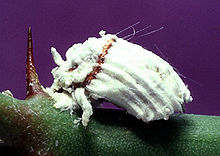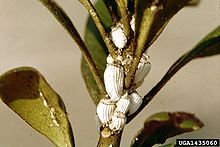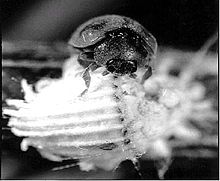- Icerya purchasi
-
Icerya purchasi 
Scientific classification Kingdom: Animalia Phylum: Arthropoda Class: Insecta Order: Hemiptera Suborder: Sternorrhyncha Superfamily: Coccoidea Family: Monophlebidae Genus: Icerya Species: I. purchasi Binomial name Icerya purchasi
Maskell, 1878Icerya purchasi (common name: cottony cushion scale) is a scale insect that feeds on several species of woody plants, most notably on Citrus and Pittosporum. Originally identified in 1878 as a New Zealand located pest of kangaroo acacia, it is now found worldwide where citrus crops are grown.
Contents
Life cycle
This scale infests twigs and branches. The mature hermaphrodite is oval in shape, reddish-brown with black hairs, 5 mm long. When mature, the insect remains stationary, attaches itself to the plant by waxy secretions, and produces a white egg sac in grooves, by extrusion, in the body which encases hundreds of red eggs. The egg sac will grow to be two to three times as long as the body. Newly hatched nymphs are the primary dispersal stage, with dispersion known to occur by wind and by crawling. Early stage nymphs feed from the midrib veins of leaves and small twigs, and do the bulk of the damage. At each molt, they leave at the old feeding point the former skin and the waxy secretions in which they had covered themselves and from which their common name is derived. Unlike many other scale insects, they retain legs and a limited mobility in all life stages. Older nymphs migrate to larger twigs and eventually as adults to branches and the trunk. Their life cycle is highly temperature dependent, as the length of time in each stage of life is longer in cold temperatures than high temperatures.
True males are uncommon to rare overall, and in many infestations are not present. Pure females are unknown. Self-fertilization by a hermaphrodite will produce only hermaphrodites. Matings of a male and hermaphrodite will produce both males and hermaphrodites.
In addition to the direct damage from sap sucking, the insects also secrete honeydew, on which sooty mold often grows and causes further damage to the host plant. Some ants will also consume this honeydew.
Biological control
Icerya purchasi is important as one of the first major successes of biological control. Importations of the vedalia ladybeetle (Rodolia cardinalis) in 1888-1889 by C. V. Riley, later head of the USDA's Division of Entomology, resulted in swift reductions of I. purchasi populations, saving the burgeoning Californian citrus industry from this destructive pest.
A second biological control, the parasitic fly Cryptochaetum iceryae has also been introduced to California as an additional control vector. Use of insecticides as a control is recommended only if no biological control species is present. Imidacloprid is especially not recommended, although it affects other scale insects, because it has no effect on this species but is very toxic to the vedalia ladybug.
References
- Hamon AB, Fasulo TR. (2005). "Cottony cushion scale, Icerya purchasi Maskell". Featured Creatures. University of Florida. http://entomology.ifas.ufl.edu/creatures/fruit/cottony_cushion_scale.htm. Retrieved 2008-07-16.
- "ARS Timeline: History of Research at the U.S. Department of Agriculture and Agricultural Research Service". USDA Agricultural Research Service. 2008-07-07. http://www.ars.usda.gov/is/timeline/insect.htm. Retrieved 2008-07-16. (originally published as 20th Century Insect Control in the July 1992 issue of Agricultural Research magazine)
- Baker, James R. (July 1994). "Cottony Cushion Scale". Ornamentals and Turf: Department of Entomology Insect Note. North Carolina State University: North Carolina Cooperative Extension. http://www.ces.ncsu.edu/depts/ent/notes/O&T/shrubs/note51/note51.html. Retrieved 2008-07-16.
- T. R. Fasulo and R. F. Brooks (October 1993, revised June 2004). "Scale Pests of Florida Citrus". Entomology and Nematology Department, Florida Cooperative Extension Service, Institute of Food and Agricultural Sciences, University of Florida. http://edis.ifas.ufl.edu/CH059. Retrieved 2008-07-16.
- Grafton-Cardwell, E. E. (December 2003). "Cottony Cushion Scale". How to Manage Pests: Pests in Gardens and Landscapes. University of California Statewide Integrated Pest Management Program. http://www.ipm.ucdavis.edu/PMG/PESTNOTES/pn7410.html. Retrieved 2008-07-16.
External links
Categories:- Scale insects
Wikimedia Foundation. 2010.


